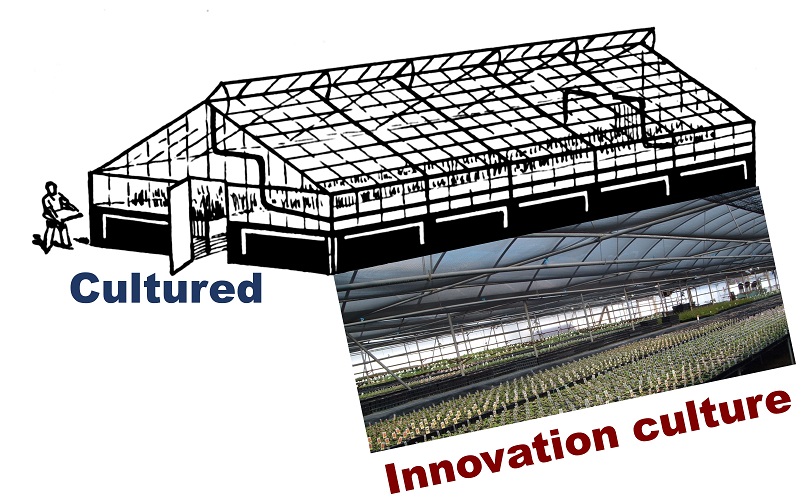In the previous post I defined ‘culture’ and explained how a specific element of culture can be built or shaped by persistent use of processes in the organization. The innovation enthusiasts wanted me to give some examples to convince them that the culture can be shaped through processes. Some others asked for a few examples of processes that could help in building or shaping the innovation culture.
Have you heard of ‘Cultured pearl’ or ‘Cultured yeast’? I am sure many of you would have heard of ‘Cultured blood test’ and ‘cultured urine test’! What is the meaning of ‘cultured’ in these phrases?
Cultured-Pearl
A natural pearl is formed by accident when the oyster, mussel or clam is injured by a parasite or an attack of a fish that damages the external fragile rim of the shell. In response, as a healing process the animal secretes nacre and a cyst is formed, which is nothing but a pearl. Cultured pearl, on the other hand, is a process to grow pearls by inserting a tissue graft from a donor oyster, upon which a pearl sac forms and the inner side precipitates nacre.
Cultured-Yeast
Natural yeasts usually consist of a mixture of different yeast strains and every strain has its own characteristics and effects foods in different ways. When natural yeasts are used in food production it is unknown which strain will reproduce fastest and what the effect on the food will be. Quality, smell and taste of the finished product may vary and are basically left to chance. On the other hand, Cultured yeasts are yeast strains cultured and optimized for certain uses. They only consist of one strain of yeast and do not contain mold, bacteria or other yeasts. Cultured yeasts are supposed to change a food positively in a predictable manner and hence are used in professional food production.
Cultured-blood test and cultured-urine test
Urine and blood are sterile environments and the infection due to presence of bacteria is difficult to detect. Blood and urine culture tests are nothing but a process of growing bacteria (and other germs) in the blood or urine in a controlled environment (laboratory) in an accelerated manner to test the presence of an infection or bacteria.
Now let me ask you again – What is the meaning of ‘cultured’? It means:
- Refined (as in yeast) by following a process
- Artificially nurtured or grown (as in pearl) by following a process
- Cultivated or tilled (as in pathological tests or pearl) by following a process
Now what if I say, ‘What would Cultured-culture mean?’
Cultured-culture
Just like someone in the 20th century discovered that pearl could be cultured, we need to come to grips with the fact that culture too can be cultured. The simple meaning of ‘cultured culture’ would be: Refined/nurtured/cultivated culture by following a process.
Definition of ‘Innovation culture’
Below is the reproduced text from Wikipedia on ‘Cell culture’:
Cell culture is the process by which cells are grown under controlled conditions, generally outside of their natural environment. Cell culture conditions can vary for each cell type, but artificial environments consist of a suitable vessel with substrate or medium that supplies the essential nutrients (amino acids, carbohydrates, vitamins, minerals), growth factors, hormones, and gases (CO2, O2), and regulates the physio-chemical environment (pH buffer, osmotic pressure, temperature). Most cells require a surface or an artificial substrate whereas others can be grown free floating in culture medium.
If I was tasked to create a Wikipedia entry for ‘Innovation Culture’, it will be a simpler exercise as I will replace the word ‘cell’ by ‘innovation’ and make a few changes to bring the right context:
Innovation culture is the process by which innovations are grown under controlled conditions, generally outside of their natural environment (of an established organization). Innovation culture conditions can vary for each innovation type (disruptive, radical or incremental), but artificial environments consist of a suitable organization structure with leaders who supply the essential nutrients (knowledge, resources, perseverance, energy) and regulate the physio-psychological environment (agility, teamwork and forgiveness). Most Innovations require a separate structure whereas others can be grown freely in existing structure.
Cultured ‘Innovation culture’
Let us put together the meaning of ‘cultured innovation culture’:
Refined/nurtured/cultivated process of creating controlled environment/conditions in which innovations are grown or accelerated.”
In the next two posts I will give four scenarios that hinder innovations (Drag 1,2 and Drag 3,4) in organizations and how processes could help in overcoming them. If the processes are followed persistently and employees enjoy and take pride in following them, it would result in an enabling culture for innovations.
References:
http://www.dictionary.com/browse/cultured
http://www.thefreedictionary.com/cultured
https://en.wikipedia.org/wiki/Blood_culture
http://en.foodlexicon.org/r0001230.php
https://en.wikipedia.org/wiki/Cultured_pearl
http://wikidiff.com/culture/cultured

